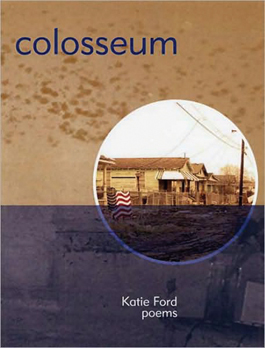home | metro santa cruz index | the arts | books | review

Book Reviews
'Colosseum' and 'The Scotia Widows.'
Colosseum
By Katie Ford; Graywolf; 64 pages; $15 paperback
Many of our greatest poets came to us in ruins. The gouging lyrics of the Greek poet Sappho, for instance, were rescued from strips of papyri. Heraclitus was famous in his time, but all we have left of his great works are fragments that echo powerfully, spookily across the millennia. What happens, though, when a poet sets out to construct a ruin 2,000 years in advance? The result is a book like poet Katie Ford's new volume, Colosseum--a collection full of self-conscious occlusions, far-reaching links and some oracular, beautiful lines. Before Ford moved to Philadelphia, she lived in New Orleans, and this book is haunted by the storms that transformed that city forever. The poems about that event, and its aftermath, are the strongest work in the book. Ford worries less about what the event means and more about how to bring it to life in a poem. And she can do that heartbreakingly well. Ford's sludgy lines eddy and snag on unexpected lyricisms: "Blue tarps drape the oysters / harvested from contaminated beds," she writes in "Fish Market," "silverlings caught from trestles of the resealed lake." "Snakes" is another marvelous, deeply upsetting piece of work. "In New Orleans, snakes followed the flood / into the houses," she writes. "They moved like completely sane machines, able to execute / their bodies perfectly. Little storms all over, / coil after coil of mimicry." Colosseum, if it's not clear already, is pitched as a work of testimony. The weight of that role presses down hard on some of these poems, though. "I wanted so much to be and swallow and / carry and bear and have a mind to mind," Ford writes in "Vessel." Unfortunately, this desire to make the flood mean something--an understandable human wish after so much destruction--strangles some of Ford's poems, turning them into a state of breathless lament: "Something please tell me I'm wrong / about impermanence," she writes in "The Shape of Us." Searching for a narrative, a context, a line out of now into the past, Ford detours through the savaging of other cities--Beirut, Damascus, Nagasaki--but none of these poems have the power of those about New Orleans. The world is vast and full of suffering, indeed; sadly, Katrina was hardly the beginning. If only, though, this poet had recognized that the destruction of one city is enough to move us.
John Freeman
The Scotia Widows: Inside Their Lawsuit Against Big Daddy Coal
By Gerald M. Stern; Random House; 145 pages; $20 hardback
A very simply written account of Gerald M. Stern's complex case against the Blue Diamond Coal Company; it ran four years from the initial 1976 disaster to the final settlement. The Scotia, Ky., tragedy was one of two disasters in the same mine in the same week; in the first, negligent ventilation suffocated 15 trapped men. What happened at Scotia led directly to the Federal Mine Safety and Health Administration Act of 1977. Still, the odds against the plaintiffs were high. Stern states his case: "Blue Diamond's reckless pursuit of more coal and money, in the face of an unsafe ventilation condition, had killed their husbands, destroyed their own lives and dreams, and left children who would never see their fathers again." Kentucky's workmen's compensation laws favored the coal companies, and then there was a shell game about which side of the Kentucky/Tennessee line the mine's ownership was on. The opposition lawyer was Bert Combs, a popular Kentuckian who had previously been the first Appalachian governor of that state. The judge, H. David Hermansdorfer, turned out to be secretly receiving royalties for coal mining on his own private land. In self-effacing, cautious prose, Stern, co-founder of Rogovin, Stern and Huge, sums up the details of a David and Goliath struggle. He also mentions the shunning that went on in the small towns around the mine, where the miners' widows were stigmatized as troublemakers and fortune hunters. One plaintiff had her house vandalized; another committed suicide. Seeing this story as a triumph requires some optimism. The emasculated OSHA of the Bush years, according to Rep. George Miller, ensures that one worker dies a day on the job. Ultimately, Blue Diamond criminal liability was a fine of $60,000 tax-deductible dollars. Still, Stern proves that today's cut corner can lead to tomorrow's hefty lawsuit: "When it comes to safety, the mantra should be 'Pay me now or pay me more later.'"
Richard von Busack
Send a letter to the editor about this story.
|
|
|
|
|
|